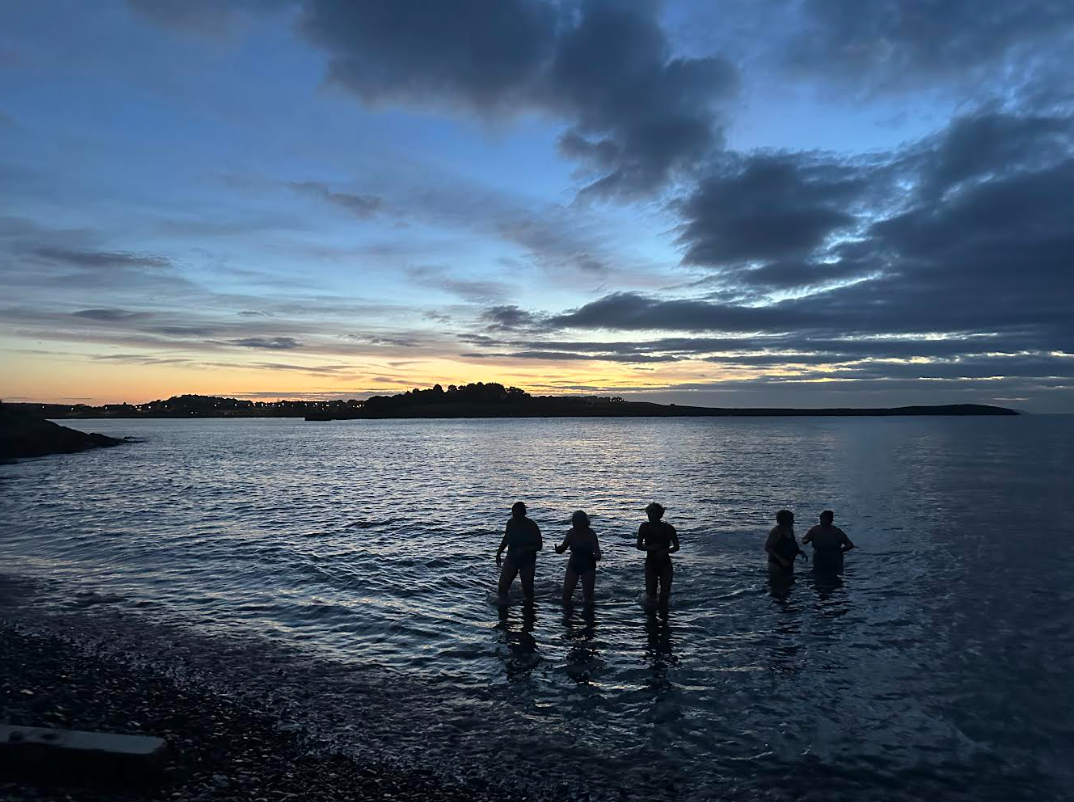If you’re stuck at home and missing the thrill of travel, say no more: embark on our international cinema journey through South America, Africa, Europe, and more to come soon.
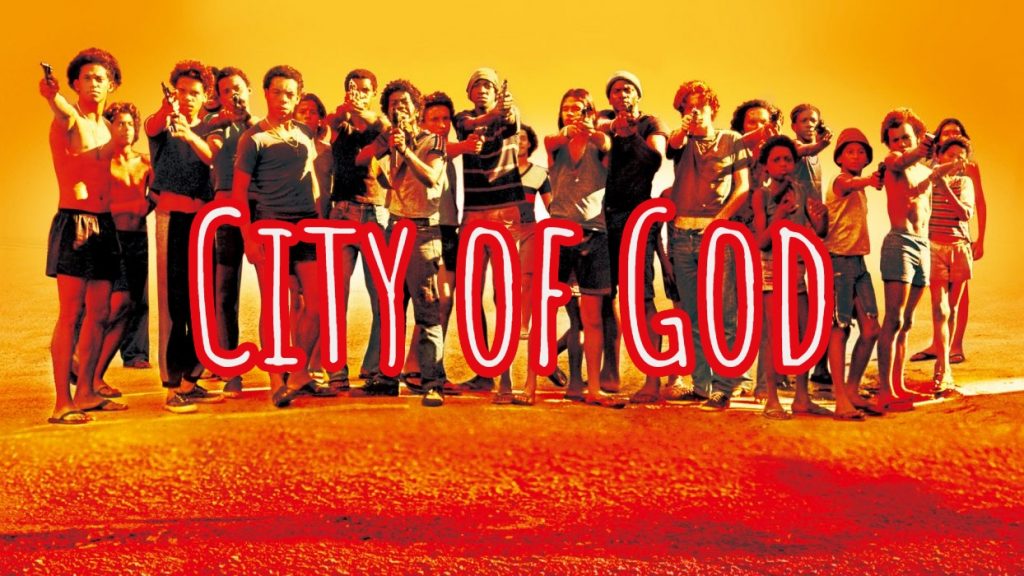
BRAZIL
City of God (2002) – Fernando Meirelles and K├ítia Lund
By Ella Lloyd
Based on the 1997 Novel of the same name, City of God is a great place to start if you’re unfamiliar with foreign cinema. Although it takes influence from the Brazilian Cinema Novo movement of the 1960s and 70s in its criticisms of inequality, police, and government, it’s more similar to mainstream Hollywood gangster film, in its plot and characters. It follows the story of Rocket, a young man growing up in the toughest favela of Rio de Janeiro through his childhood in the 60s, and finishing in the late 70s. Although Rocket has many friends involved in the drug trade he wishes to escape favela life and become a photographer. In this way, it is also a coming of age tale.
It features an episodic, non-linear storyline and often diverts to tell the story of others in the favela, and how their stories intertwine in an internal politics. Using a clever colour palette, documentary-esque handheld shots and tight framing, it parallels the humid poverty of the favelas with the sun kissed, post card image of Rio.
Fast paced, exciting, and intense: it’s a sex, drugs, and gangs story familiar to western audiences, executed with flair and precision that captures the essence of the favela perfectly. However, it doesn’t forget to remind the audience that this is based off of a true story, and hammers this home with scenes of less theatrical, more harrowing violence.
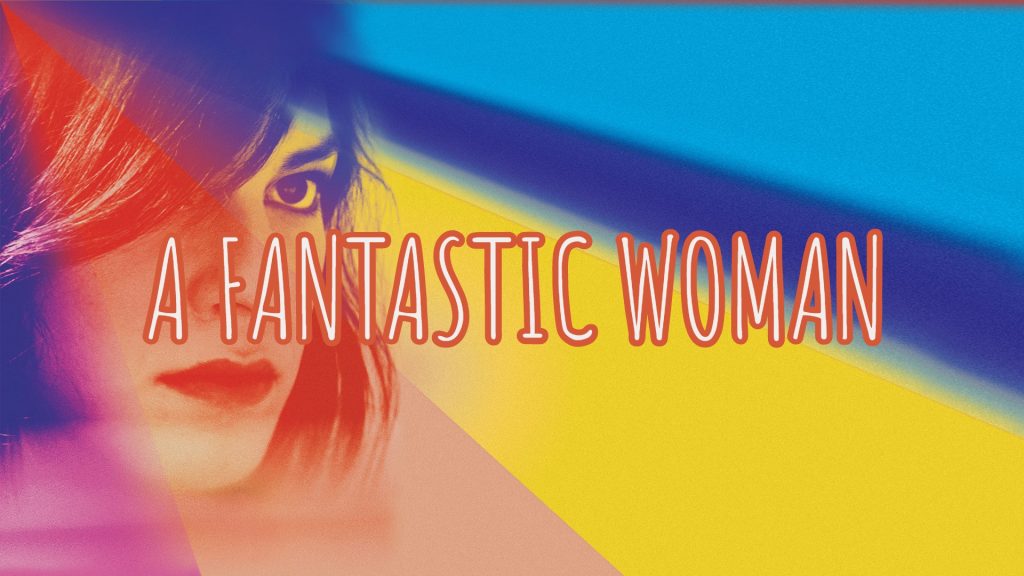
CHILE
A Fantastic Woman (2017) – Sebasti├ín Lelio
By Anna Heledd
Despite having the most forward thinking laws regarding the protection and liberation of the trans community, South America has the highest deaths for the transgender community in the world. A Fantastic Woman is a Chilean film depicting the life of a transgender woman after her partner dies in ambiguous circumstances. It’s a film that combines the factual struggles of transgender women in Chile and the film technique of magical realism, which is a style of fiction that paints a realistic view of the world whilst adding magical elements. It’s a fun and exciting way of storytelling that’s been popular in Latin America for decades, that a western audience has arguably never seen before.
Unlike a lot of British films which attempt to discuss this specific topic, the main character is played by Daniela Vega, a trans Chilean woman herself. When her partner dies, Marina goes through hell to maintain her dignity and independence. She’s kicked out of her apartment she shared with him by his family and receives nothing in the will, despite living with him for ten years. She’s referred to with her birth name, as the Police refuse to acknowledge her as a trans woman. The film realistically details the abuse that transgender people face in Chile everyday, from both the public and the justice system. What breaks your heart the most when you watch this is how normalised Marina seems to be to this treatment, it’s a pattern in her life she has had to overcome to simply survive as who she wants to be.
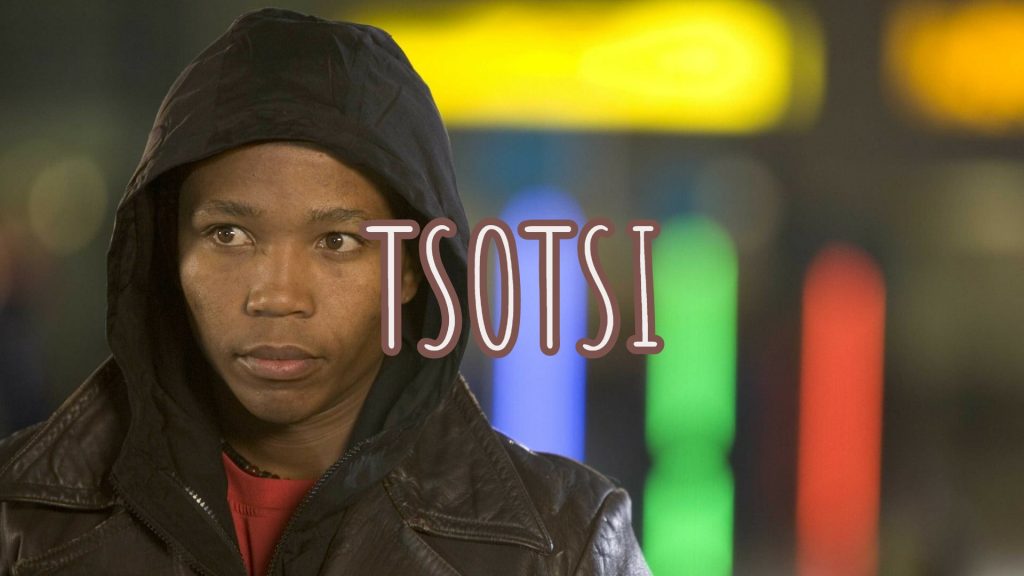
SOUTH AFRICA
Tsotsi (2005) – Gavin Hood
By Nicole Rees-Williams
Tsotsi (2005) translated to ÔÇÿthug’ in English is directed by Gavin Hood and details a touching story following a young gang leader living in the suburbs of Soweto, South Africa. Tsotsi turns to crime to survive and shoots a young woman in order to steal her car. Later, however, he discovers that there is a baby in the back seat and his entire world gets turned upside down.
The story follows a range of twists and turns, building an emotional unexpected bond between Tsotsi and the child whilst displaying the harsh reality of poverty and gang culture in South Africa. Tsotsi is introduced as someone to be feared, a criminal, but the unfolding of the story reveals his criminal nature as a result of a parentless, poverty-stricken child doing what he can to survive. Not all hope is lost for Tsotsi, and the responsibility of childcare brings out the good in him that was always there. The story is also topical to its continent, highlighting the division between the cities and the shanty towns, the HIV/AIDS crisis and the lack of available education to the less fortunate. From the bond of motherhood, to the tragic reality of murder, Tsotsi is a poignant story worth watching.

ZAMBIA
I am Not a Witch (2017) – Rungano Nyoni
By Suraya Rumbold-Kazzuz
Rungano Nyoni, a Zambian/ Welsh director and writer, debuted with a very surreal and important film: I am not a Witch. The film explores the ways in which superstition and misogyny combine to create power imbalance and manipulation within communities.
When Shula, an eight year old who lives in a remote Zambian village, is accused of being a witch by her community, Mr Banda, a government official decides to take capital on her person and notices Shula’s potential to help his business. He sends Shula to become a part of a travelling witch camp and lets her know that should she try to escape she shall turn into a goat that may be killed for food. Shula, alongside many other women, becomes trapped and enslaved ÔÇô but Mr Banda realises that he can use Shula in order to gain celebrity. He forces her to go on TV and enact her ÔÇÿwitchcraft’. The entire film switches back and forth from tense and poignant scenes to satirical drama ÔÇô not allowing the audience to ever be comfortable with what they are seeing on screen.
The film is a must watch for those who are looking for a something that will allow them to look outside of themselves and focus on the wider picture. The film is like no other, the plot is intriguing and challenging. While the film is set in a Zambian village ÔÇô the base questions of morality can and do apply to all communities. The film will make you think about the ways in which the society we live in ÔÇô the western world ÔÇô is not all that dissimilar to the one in which Shula lives too.
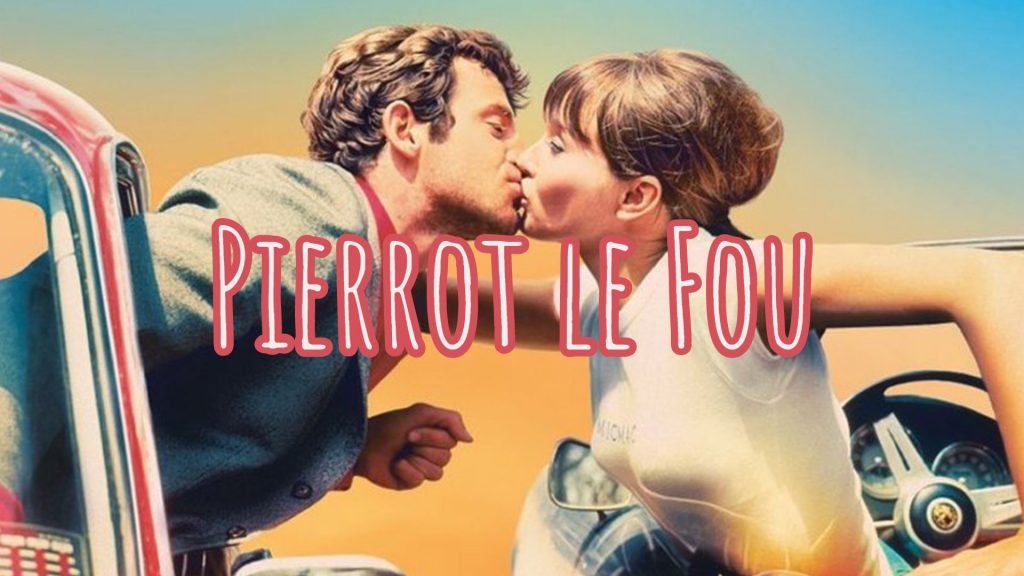
FRANCE
Pierrot Le Fou (1965) – Jean-Luc Godard
By Amelia Field
Watching Pierrot le Fou is like sitting out in the sun on a hot day listening to Edith Piaf on loop. This puzzling piece of cinema leaves you confused at points but there is a certain joy within this, trying to pull on strings to be able to fully understand the plot. Alongside this is the cinematic element of this film. Godard’s use of colour is magnificent. First utilising neon and bright lights when the protagonist Pierrot or Ferdinand as he insists on being called, is growing tired of his bourgeois existence. Then Dogard transitions into more muted natural colours as the couple run away together and explore the countryside. The juxtaposition of the serious writer and poet to the whimsical child like babysitter is a beautiful relationship to behold.
Although the two main characters strive to escape they world to improve themselves in the end, they fail to do so. In a traditional film narrative this would be viewed as the sign of failed character development but within this film it offers more of a comforting narrative that despite the desire to have uproot and forget ones past life there are always certain things which will stay the same. The film ends on a Romeo and Juliet esc final scene which is oddly calming for the content it displays. For any hopeless romantics out there this is a great watch!
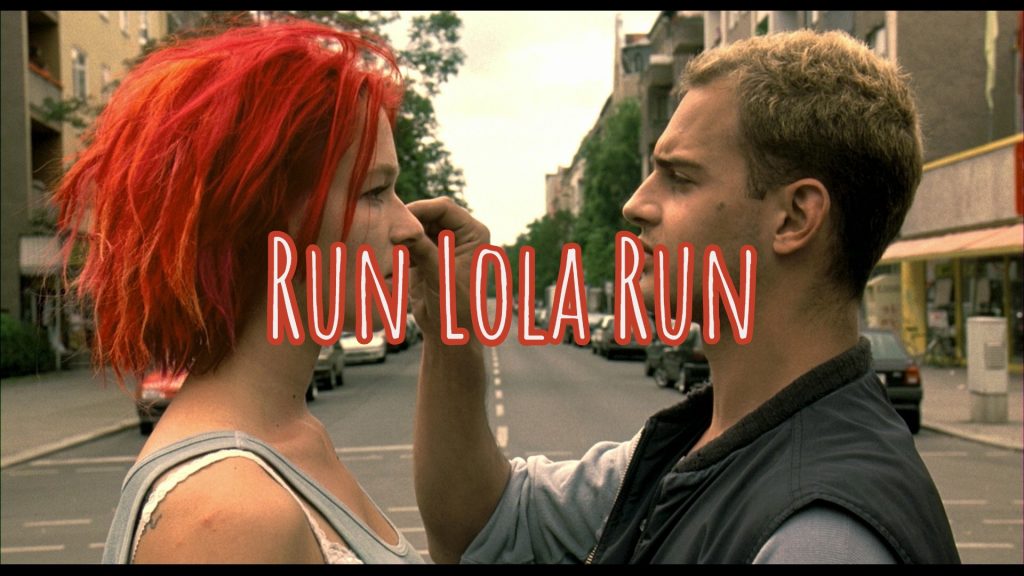
GERMANY
Run Lola Run (1998) – Tom Tykwer
By Louise Gammage
Three chances. Two young Germans. One reality.
Exhilarating from start to finish, Tykwer’s Run Lola Run highlights the importance of split-second decisions and the extent to which they can change your life. The film begins with Manni recalling to his girlfriend that he’s accidentally left the money he owes a criminal on a train. Lola realises it’s down to her to find 100,000 DM in 20 minutes before he robs a supermarket. Every time she fails, she gets to restart and make different choices- resulting in three extremely dramatic outcomes.
Run Lola Run is a refreshing film in the world of German cinema. Mirroring the techno scene of 1990s Berlin, Tykwer uses EDM as the primary soundtrack for the film. Techno music, video game characteristics, and urban life are all key themes in the editing of the film- which were all also fundamental features of reunified Germany.
Tykwer employs cartoon animations at the beginning of each of Lola’s attempts, portraying Lola’s life as a video game. These cartoons are bright and colourful, reflecting the retro feel to Berlin in the 90s which is renowned for its abstract culture and wild spirit.
Different to all films of its kind, Run Lola Run is an exciting, thrilling and light-hearted film to watch- exactly what we need during times like now when we are all stuck inside. There is no better time to indulge yourself into German cinema and experience its unique culture, as is perfectly displayed in Run Lola Run.
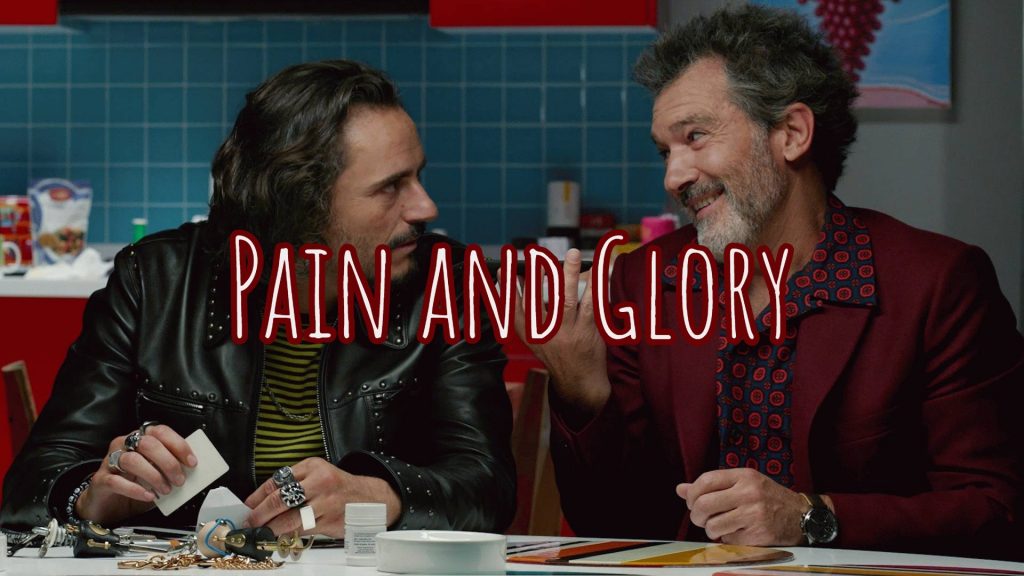
SPAIN
Pain and Glory (2019) – Pedro Almod├│var
By Isobel Roach
With two Oscar nominations behind it, Pedro Almod├│var’s 2019 film Pain and Glory was as popular with critics as it was with cinemagoers. It’s easy to see the appeal; with Antonio Banderas in an award-winning lead role, Almod├│var’s film follows the trials and tribulations of an aging director as he tries to make sense of his past, present and future. With an undercurrent of darkness and suffering ÔÇô most notable in the chronic illness and drug abuse of Banderas’ Salvador Mallo ÔÇô Pain and Glory is a visually stunning movie. Each frame is saturated with a burst of colour that almost verges on the gaudy, but cinematographer Jos├® Luis Alcaine balances this bold palette with shots that are imbued with a sensitivity and tenderness for their subject matter.
Yet despite its focus on Mallo’s suffering, Pain and Glory is not a relentlessly tragic film; it’s ambivalent, honest and occasionally very optimistic. In Almod├│var’s film, the past can be recovered and recontextualised ÔÇô the future is a thing that has not yet been written. Mallo’s attempts at rewriting his formative years into an ambitious one-man stage show embody the film’s ethos of rebirth through trauma. So if you’re looking for a movie to while away the hours in quarantine ÔÇô something that’s challenging but hopeful ÔÇô Pain and Glory is well worth the ┬ú4.49 renting fee over on Amazon Prime!
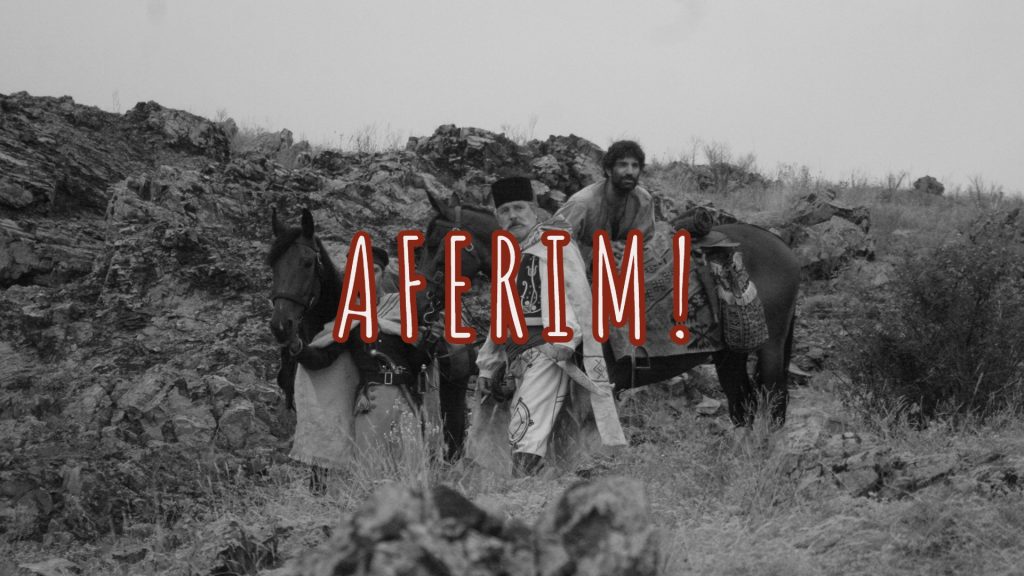
ROMANIA
Aferim! (2014) – Radu Jude
By Francesca Ionescu
In 1800s Romania, a landowner’s slave runs away and tasks the local Constable and his untrained son with tracking him down and bringing him back to his owner. Aferim! is only the second Romanian film that depicts the enslavement of the Romani people, which is often ignored as an issue, leading to the endemic socio-economic struggles which the Romani people bear today, both in Romania and across the world. The film starts off slow, in a Western movie style, horse riding through beautiful scenery and empty fields. Despite being filmed in 2015, Aferim! is shot in black and white, using wide shots and no close ups on a singular character, as a tribute to traditional Romanian cinematography.
The views and language are accurate for the 19th century the movie is depicting and while crude, make the viewer learn a lot more about the characters and what they represent. As someone raised in Romania this is an emotional reminder of history and an accurate depiction of how cruel the country has treated the Romanis. I would recommend it to anyone not familiar with Romania too, as while the subtitles aren’t great and miss out important bits of dialogue, they’re enough to show you a world you wouldn’t imagine, too often forgotten.

